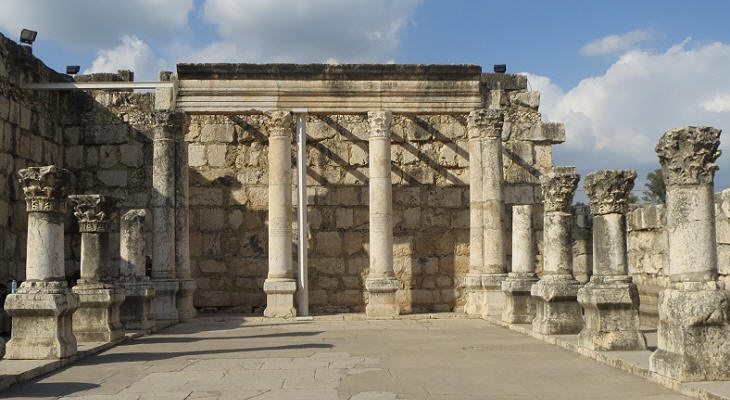 |
| 4th century synagogue, Capernaum, courtesy RomeArtLover.it |
A
major archaeological site, excavations in Capernaum have revealed two ancient synagogues, one built over the
other, the most recent, dating back to the 4th century. In Christian tradition, one Sabbath, while sojourning in Capernaum, Jesus healed a servant of a
Roman centurion. This servant later built the first synagogue and this became the
place where Jesus preached. According to the Synoptic Gospels, he selected
Capernaum as the center of his public ministry in Galilee after he left the
small mountainous hamlet of Nazareth (Matthew 4:12–17). Eventually though, he came to curse the town, along with Bethsaida and Chorazin, because of their lack of faith in
him as the Messiah.
Other healings by Jesus that occurred in Capernaum included the healing of Simon
Peter's mother-in-law of a fever (Luke 4:38–39),
the healing of the lepers, and the healing of the
paralytic lowered by
friends through the roof, as reported in Mark 2:1–12 and Luke 5:17–26.
Capernaum survived the Jewish revolts against Rome in the 1st and 2nd
centuries even though the Jewish historian Josephus received treatment there
after suffering a battle injury nearby along the Jordan River.
By
the 4th century, the local houses were
constructed with good quality mortar and
fine ceramics. This was about the time that the synagogue, now familiar to
Israelis and tourists alike, was built. This synagogue contained a relief
depicting one of the earliest representations of the Magen David (Star of
David). There were some European archaeologists early in the 20th
century who believed that it also contained an upper floor reserved for women,
with access by means of an external staircase located in a small room. But this
opinion was not substantiated by later excavations. There are two inscriptions
on the site, one in Greek and the other
in Aramaic,
that commemorate the benefactors that helped in the construction of the
building. There are also carvings of five- and six-pointed stars and of palm
trees.
Capernaum
remained inhabited for several centuries since its founding. It was revived
after the earthquake of 749 but was later abandoned in the 11th century,
shortly before the Crusader
conquest. Archaeological
activities at the site, as well as throughout the country, began in the early
19th century. By 1866, the British Captain Charles William Wilson identified the remains of the synagogue, and in
1894, the Franciscan Friar Giuseppe Baldi of Naples, the Custodian of the Holy Land, was able to recover a good part of the ruins from the Bedouins. The Franciscans raised a fence to protect the ruins from frequent vandalism, and
planted palms and eucalyptus trees brought from Australia to create a small oasis for pilgrims. The most important excavations began in 1905 under the direction
of German archaeologists Heinrich Kohl
and Carl Watzinger. They were continued by Franciscan Fathers Vendelin von
Benden (1905–1915) and Gaudenzio Orfali (1921–1926). The excavations resulted
in the discovery of two public buildings, the synagogue and an octagonal
church. In 1926, Father Orfali began the restoration of the synagogue. The work was
interrupted by his death in a car accident later that year (which is
commemorated by a Latin inscription carved onto one of the synagogue's
columns), and was continued by Virgilio Corbo beginning in 1976. Excavations
have been ongoing, with some publication on the Internet as recently as 2003.
No comments:
Post a Comment